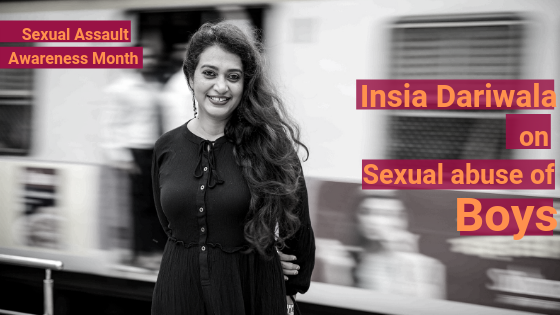We can’t expect our girls and women to be safe unless our boys are also kept safe: Insia Dariwala on Sexual abuse of Boys

In the last couple of years, the #Metoo movement has succeeded in building up momentum in speaking out against gender violence. As the wave made its way across the globe, it provoked and received deserved attention. Even as it kickstarting important conversation and changing the status quo, some voices were louder than the others.
This April 2019, on the occasion of sexual assault awareness month, we focus on some of these unheard voices.
‘Do boys also get sexually abused?’
There is readily available data from across the country and the world that clearly posits that boys are almost equally at risk as girls.
Statistics from the 2007 report on child abuse in India by the Ministry of Women and Child Welfare One in every two children interviewed (53.22%) reported being victims of one or more forms of sexual abuse that included severe and other forms.
More than half (52.94%) of those who reported abuse were boys while 47.06% were girls. Of all the children reporting sexual assault (penetration of the anus, vagina or oral sex), 54.4% were boys.
These statistics are alarming, but the sexual abuse of boys continues to be under-recognized, under-reported and under-treated.
While many were uncomfortable bringing up the issue, Insia Dariwala, filmmaker and social activist, took it on herself to spread awareness around the susceptibility of young boys to sexual abuse.
In her conversation with Aarambh India, she shared how there has always been silence around the issue.
‘Back in 2009 during research for my film ‘The Candy Man’, I met multiple people who have been through sexual abuse. Some of them were boys. That got me thinking on the need for weaving in their narratives to create more awareness on this issue. I felt such stories needed to be told.’
With this thought, Insia gender-swapped the protagonist of her film from a girl to a boy. This was just the beginning of her engagement with the issue
But what makes it more difficult for boys to share their experiences or seek help?
Insia explained how the privileges of patriarchy for men are often delusional- “Coming out and disclosing sexual abuse is difficult and often takes time. It took me years to finally talk about my sexual abuse as a child. But for men, there is an added burden of toxic masculinity. Boys grow up with an ingrained mindset of being told they are protectors, and protectors are meant to be strong. How can a ‘protector’ be weak or vulnerable? How can protectors ask for protection?”
Insia details how patriarchal systems make it almost taboo for boys to express their feeling or come across as less than self-reliant. This takes away and represses the help-seeking impulse that abused boys may feel. They may shroud the pain in silence rather than speak out and reach out.
Boys are socialized to be proud of early sexual conquest, even if it may be unwanted. Thus all sexual activity, even abuse, is perceived more like a game.
Then there is the larger social stigma of homosexual behavior. In case the offender in question is a man, boys are reluctant to disclose. They may not feel able to face up to the social shaming.
Also, boys are given more freedom when it comes to accessing public spaces or interacting with different kinds of people. This not just makes them easy targets for offenders but once an incident of abuse takes place, boys feel that disclosing may lead to their freedoms be taken away
“Through my work,” she says “I realized it is important to ask questions like who are these perpetrators, and what drives them to do such heinous crimes on children.”
“ I strongly feel that the past holds the answers. Unless we fix the past, we can’t fix our present and future. We can’t expect our girls and women to be safe unless our boys are also kept safe.”
Fortunately, her petition was well received by the Ministry and in 2018 she was invited to lead an all-India study on male child sexual abuse. The study is on-going. Once it is done, the data will be used to formulate creative and effective preventive tools to prevent and arrest incidences of child sexual abuse.
“Policy changes are one part of the solution. POCSO is gender-neutral but we need more laws that address the needs of every victim, whatever be their gender.”
She adds, “But along with policy change there needs to be a collective effort from all stakeholders in society to help end CSA.
“ We first need to have more conversations about this issue in homes, because that’s where most of the abuse is happening- ‘in a seemingly safe environment’. The conversations around safety should start from the families. For decades families have unknowingly nurtured an environment which breeds patriarchal mindsets that stifles the voice of women & children & creates unbridgeable gender divides.”
“If we want our society to be free of Child sexual abuse, it is important to first examine the role of the ‘home’ in this context.”







